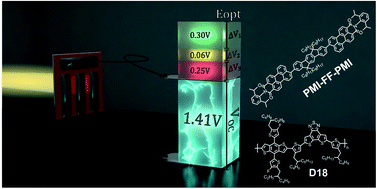Wide-bandgap organic solar cells with a novel perylene-based non-fullerene acceptor enabling open-circuit voltages beyond 1.4 V†
Abstract
A perylene-based acceptor (PMI-FF-PMI), consisting of two perylene monoimide (PMI) units bridged with a dihydroindeno[1,2-b]fluorene molecule was developed as a potential non-fullerene acceptor (NFA) for organic solar cells (OSCs). The synthesized NFA was combined with the high-performance donor polymer D18 to fabricate efficient OSCs. With an effective bandgap of 2.02 eV, the D18:PMI-FF-PMI blend can be categorized as a wide-bandgap OSC and is an attractive candidate for application as a wide-bandgap sub-cell in all-organic triple-junction solar cell devices. Owing to their large effective bandgap, D18:PMI-FF-PMI solar cells are characterized by an extremely high open-circuit voltage (VOC) of 1.41 V, which to the best of our knowledge is the highest reported value for solution-processed OSCs so far. Despite the exceptionally high VOC of this blend, a comparatively large non-radiative voltage loss (ΔVnon-radOC) of 0.25 V was derived from a detailed voltage loss analysis. Measurements of the electroluminescence quantum yield (ELQY) of the solar cell reveal high ELQY values of ∼0.1%, which contradicts the ELQY values derived from the non-radiative voltage loss (ΔVnon-radOC = 0.25 V, ELQY = 0.0063%). This work should help to raise awareness that (especially for BHJ blends with small ΔHOMO or ΔLUMO offsets) the measured ELQY cannot be straightforwardly used to calculate the ΔVnon-radOC. To avoid any misinterpretation of the non-radiative voltage losses, the presented ELQY discrepancies for the D18:PMI-FF-PMI system should encourage OPV researchers to primarily rely on the ΔVnon-radOC values derived from the presented voltage loss analysis based on EQEPV and J–V measurements.



 Please wait while we load your content...
Please wait while we load your content...